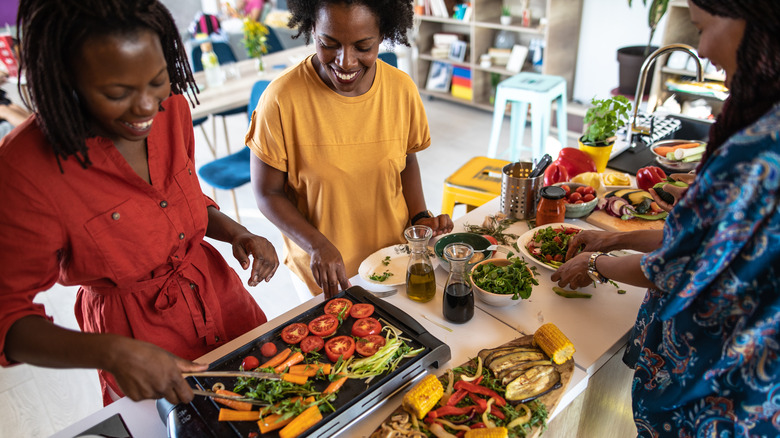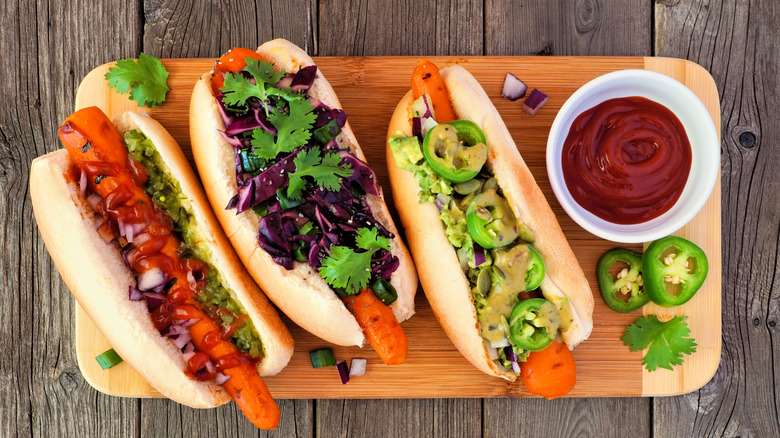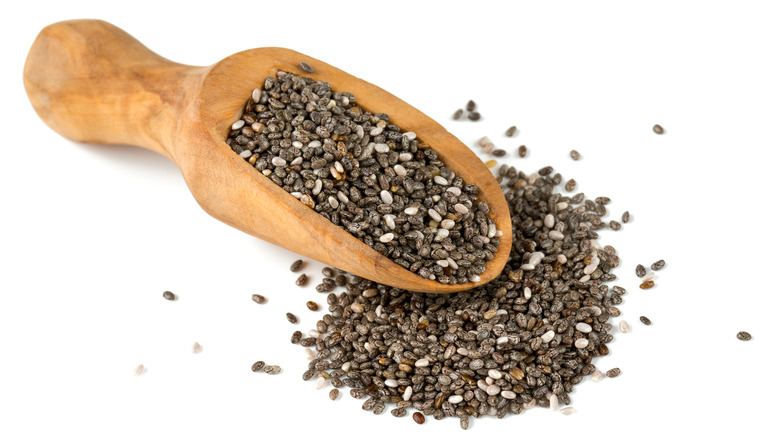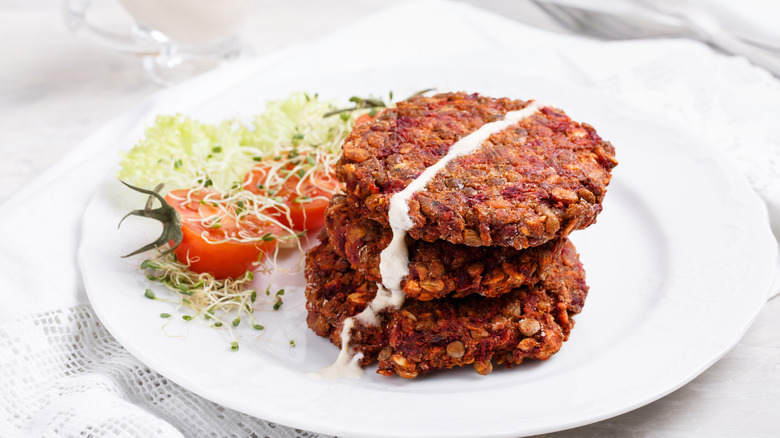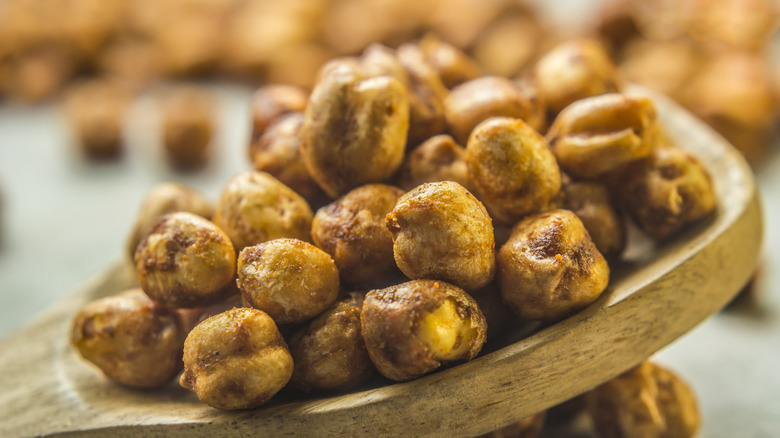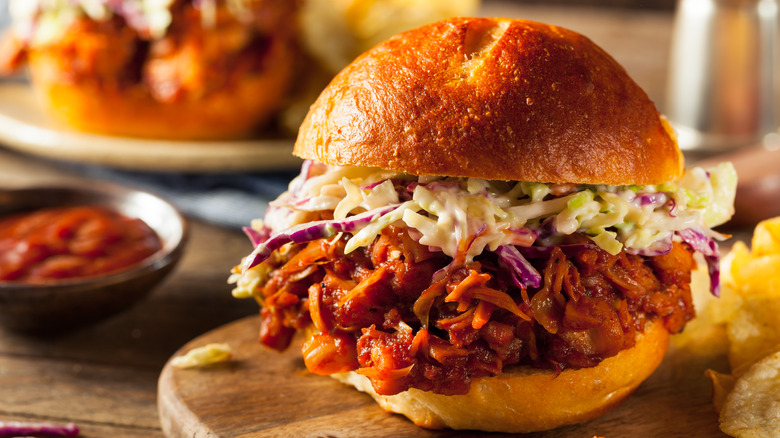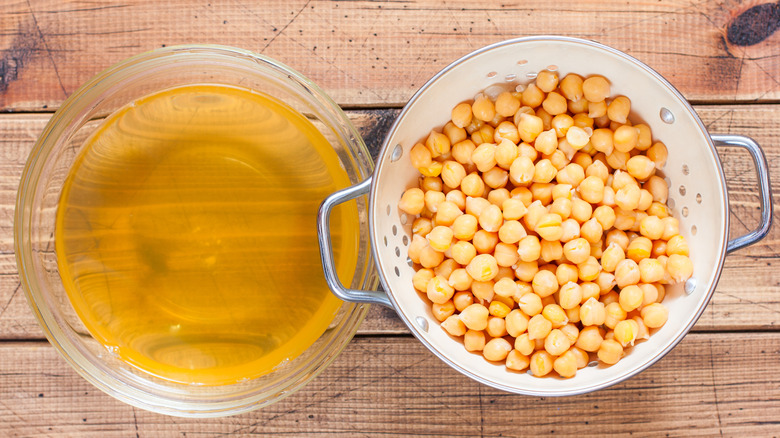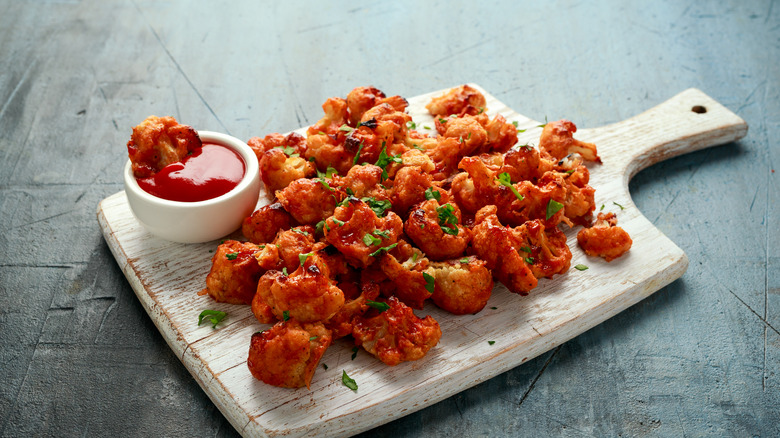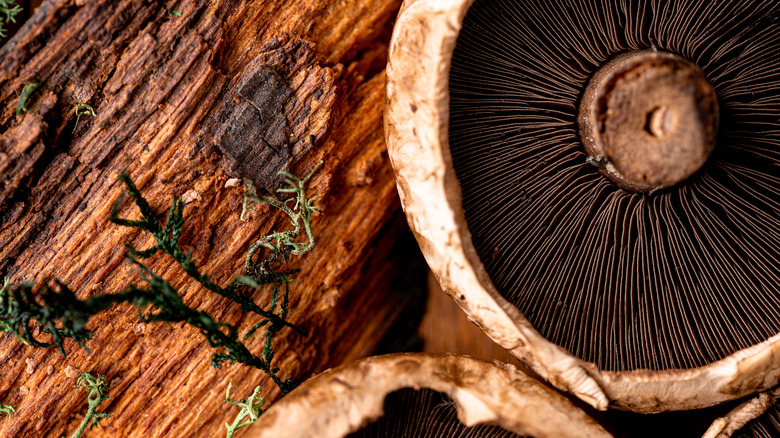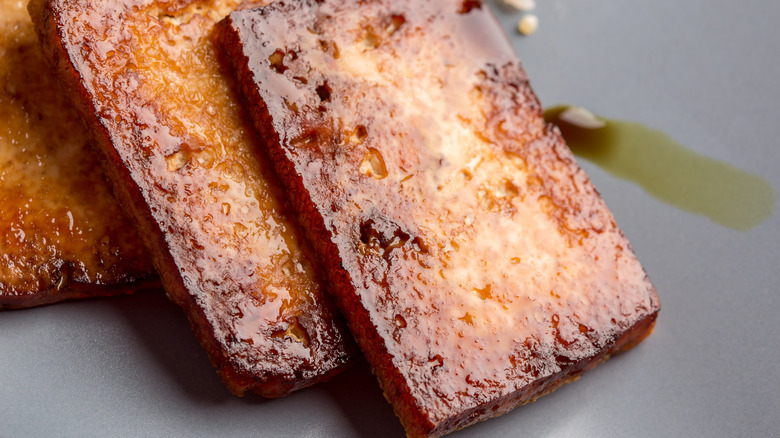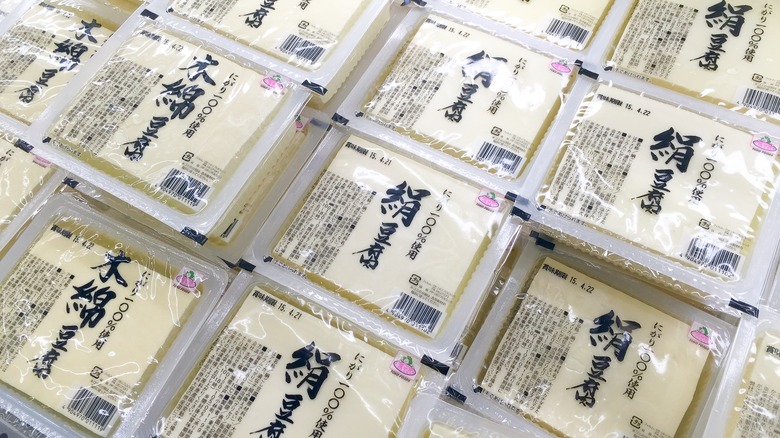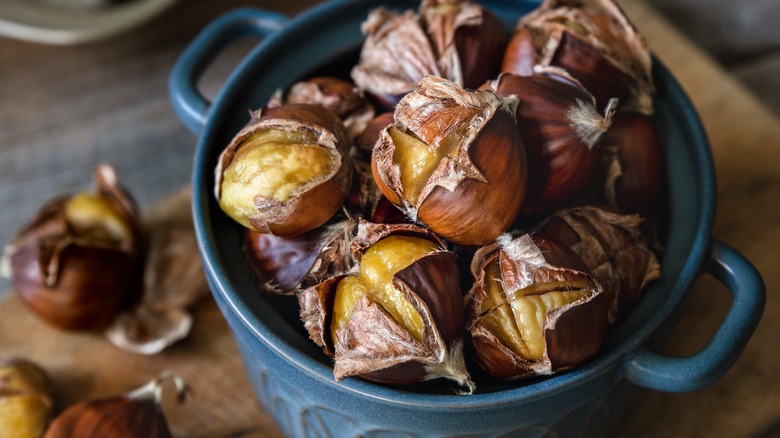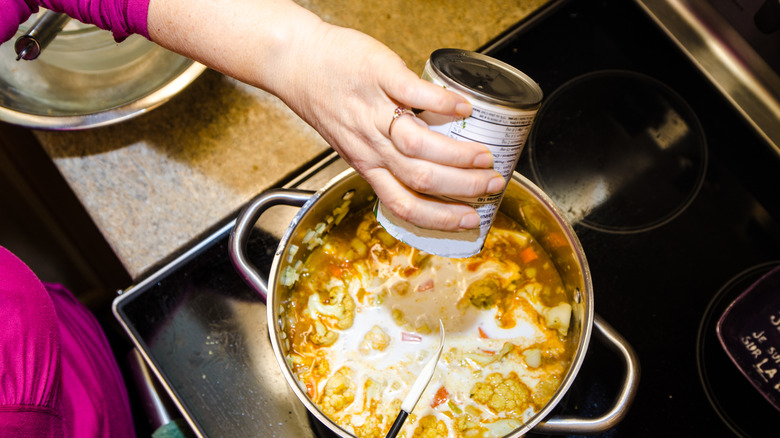Simple Hacks And Tips For Homemade Vegan Comfort Foods, Ranked
A DIY attitude is the secret ingredient to great vegan cooking. There's no shortage of faux meat alternatives that mimic familiar flavors and fare well in a deep fryer, but there is an entire world of vegan comfort food that lets us enjoy much more than fake sausage patties. Hacks, workarounds, and secret sauces exist to make all the food you thought you had to give up when you took the pledge.
Even if you're not eating fully plant-based, we wager there's a space in your meal plan for some of these game changers. They'll switch up your routine without making you spend the entire afternoon in the kitchen. In fact, with a little TLC, these vegan comfort foods will bring flavors to the table that Easy Mac could only dream about.
This article isn't here to deliver a sermon on the virtues of a healthy and sustainable vegan diet. This is all about how easy and delicious it can be with a little creativity.
13. Grill Carrots for Hot Dogs
Grilling carrot dogs rank last on our list of vegan hacks. It's not as simple as popping a carrot in a bun and putting it in the microwave. Before those carrots hit the flames, they need a spa day of boiling and a luxurious soak in a concoction of soy sauce, broths, sauces, spices, and sweeteners. It's much more prep work than hot dogs are known for, and it's all too easy to grab a premade packet of veggie dogs from the grocery. Still, these dogs will be much healthier than any store-bought option, and with the right marinade, they'll come off the grill crispy, crunchy, and juicer than most store-bought hot dogs.
Carrot dogs work best soaked in a marinade similar to what you would prep for vegan bacon. Using a healthy broth base, splash in soy sauce, vinegar, maple syrup, and a few drops of liquid smoke (the key to a smoky grilled flavor), and let it mingle for the night. Once your marinated carrots and the grill are ready, finish things with the right toppings by getting creative with relishes, caramelized onions, and jalapeño mayo.
12. Replace Eggs with Chia or Flax
While the world still ponders the chicken-egg debacle, you've got a far more delightful dilemma on your hands: Chia or flax? Either way, these tiny titans are here to shake up your baking routine. Seeds of either variety that mix with water and spend some quality time in the refrigerator take on a gelatinous quality to help bind vegan baked goods.
Anytime a baking recipe calls for eggs, try combining one tablespoon of chia or flax with 2 tablespoons of water per egg. Now, don't get too excited here — this is still our second-to-last ranked hack, after all. While chia and flax bind like eggs, they won't bring the same fluffiness to the recipe. Luckily, they bring their own benefits into the oven.
These seeds are rich in omega-3 fatty acids and fiber, adding a healthy twist to your treats. Cut down on the sugar with maple syrup, sprinkle in some oats, and all of a sudden, your sweet treat has turned into an essential snack. While replacing eggs with chia and flax won't do you much good if you're hoping for an omelet, any time you've got something heading into the oven, these two superfoods are ready to bake.
11. Oats + lentil = veggie burger
Frozen veggie burgers have incredibly long ingredient lists. These burgers are great on the grill and for special occasions because they're trying to match ground beef at all costs. But you didn't go vegan to eat more beef. You became vegan to eat more oats, so why not serve some porridge at dinnertime?
Lentils and spices make for a super stew. Add on oat flour and take the combination to the flat top. Oats make a great burger glue that helps to hold everything together while adding real value to your burger's nutrition facts. You don't even need oat flour. Carefully combine all your favorite ingredients with rolled oats and a food processor and you're a few minutes away from priming up a protein-packed plant-based patty that smiles back.
Oats and lentils make a great cornerstone to vegan ground beef. Once you've got that down, you can have it your way. Throw your lentils into a mix of onions, carrots, and tomato paste for a juicy burger primed for ketchup. If you're all about the clean and simple life, it doesn't have to get any more complex than oats and lentils. Just cook up a bowl full of thick patties on Sunday night and use them in a different recipe every day of the week.
10. Pan fry Chickpeas
While hummus is a classic, there's more to chickpeas than carrot dip and curry protein. A great way to switch things up is to toss your chickpeas in your favorite blend of curry powder, paprika, and cinnamon, and cook them up in oil.
The result is Scott Conant's go-to, a crunchy protein that you can throw onto any dish or munch on as a snack — no deep-fat fryer required. Sauté your chickpeas in a pan, roast them in the oven, or let an air fryer work its magic. As long as you strain and drain, your chickpeas are ready to be whatever you need them to be. Conant's preferred canned chickpea cooking method is a good old-fashioned pan fry, and we couldn't agree more. A tablespoon or two of oil will help your chickpeas brown and crisp in less time, and don't forget to add a drop of lemon or lime juice after they come off the stove.
9. Substitute jackfruit for pulled pork
Slathered in your favorite BBQ sauce and topped with caramelized onions and vinegar, jackfruit can make great vegan pulled pork sandwiches and carnitas burritos. The tropical tree fruit adds an unparalleled texture to vegan cooking, especially when it comes from a can.
The long, dark soak it undergoes while canned has jackfruit ready to bend but not break, allowing you to pull it apart with your bare hands and mix it up without it turning into mush. You can also use fresh jackfruit for this endeavor, but the peeling and plucking process involved does not scream simplicity. Stick with canned jackfruit, which is a wash and squash away from the ready position. Mix in an earnest blend of onions, pepper, Worcestershire sauce, vinegar, ketchup, and brown sugar to complete the ensemble and set it all to simmer.
Jackfruit is cooked best in two steps: A stovetop sizzle to soften the dish and a quick roast to bring out more flavor. You can skip one of these steps, but it's worth the commitment. You can also skip these steps in favor of setting it all down in a slow cooker. Just take your time and cook it right, and you'll find juicy pulled jackfruit powered by a delicious seasoning blend is a great way to introduce skeptics to plant-based comfort foods.
8. Save your aquafaba
If you've been dumping your chickpea water down the drain, you're not alone. But today is the day we turn that ship around. Aquafaba is a stellar egg replacement and an all-around binding agent that perfects vegan cream, cheese, mousses, meringues, marshmallows, and more. The ooze from leftover bean juice works great when chia and flax seeds don't cut it, providing an airier texture and creating baking magic.
Aquafaba's festive name fits the enchanting role played by this vegan substitute, but it simply means bean water in Latin. Technically, any bean juice is aquafaba, but aquafaba made from canned chickpeas is the favorite choice of vegan bakers who find it creates a better foam than black bean juice. Whip it up with a hand mixer and a touch of cream of tartar for a whipped topping or stir it together with your favorite combinations of sugars and flours for elevated vegan desserts.
If you don't want to eat out of cans, any water that you previously used to cook dried beans is also aquafaba. That process alone will add a few more hours onto an already complicated meringue, so stick to canned chickpea liquid for your first few forays before getting too creative.
7. Fry cauliflower
Cauliflower is the wingman we all deserve, especially on wing night. Chicken wings are messy and magnificent, and you'd be forgiven if you thought that you had to sacrifice this little pleasure to go vegan. While cauliflower can't replicate the bone-suckling aspects of chicken wings, you slather those suckers up with enough sauces, and they'll give you a run for your money with no heavy processing required.
Cauliflower florets set to heat and dipped in jus are perfect for parties, easy to pop like candy and come with great customization options. Bake 'em, fry 'em, bread 'em, the kitchen's your canvas — you could eat a different style of cauliflower wings every night of the week. Once they're cooked, you've got even more creative freedom. You can dunk them deep into buffalo sauces, sweet and sour dips, and juicy lemon pepper, and they also excel when coated in a nice dry rub.
The best part is, even when you compare pre-made frozen cauliflower wings to frozen chicken wings, one serving of chicken wings has more saturated fat than an entire bag of cauliflower wings. This way, you can finally start testing the limits of an endless wing night without paying for it later.
6. Grill portobello mushrooms
Carrots are an uninspiring meat substitute, but portobello mushrooms slide into the top half of our rankings as the real deal. These meaty fungi are an easy hack for an upscale vegan grill game thanks to their versatile grill-ability. No matter how you cut them, they'll come off the grill in minutes with a great texture and a meaty tenderness. You can keep your mushrooms whole and work them like burgers, slice them up for spicy fajitas, or cube them and poke them with a stick for delicious mushroom skewers.
If you're leaning towards burgers tonight, the dense undergrowth of a portobello mushroom allows portobellos to hold onto flavors typical burgers can only dream of. Pluck out the stems, scrape off the gills, and fill that space with fun marinades. Sliced mushrooms only need a bit of olive oil, salt, and basil to pop as an incredible side dish or bowl topping. For skewer-style portobellos, marinate portobellos, onions, peppers, and zucchini and spear them all together on a long thin cookable stick of your choice.
No matter what kind of barbeque you're hosting, portobello mushrooms will make vegan comfort food pop as much as any meat option.
5. Marinate firm tofu in soy sauce and maple syrup
A classic vegan cooking mistake is under-seasoning tofu. Uninspired tofu tastes like plastic nothing and will not get anyone to consider taking a plant-based plunge. But it's not tofu's fault; the blandness is to blame.
When you're working with filet mignon, a pinch of salt and a delicate marinade might do the trick, but tofu is another ballgame. Think of the versatile block as a blank canvas that needs your creativity. It doesn't taste like much on its own, but give it a little push, and it becomes the meal base it was made to be.
A sweet and salty combination of soy sauce and maple syrup is as strong a push as any. You can finish your ensemble with sesame seeds, rice vinegar, or whatever else tickles your fancy this evening. Press your tofu between two paper towels to squeeze more water out, let your tofu sit in the marinade for a half hour, and sear your tofu just like you would a cut of steak on an iron skillet. It creates a crunchy edge that packs a robust flavor and lets your tofu's texture take care of the rest.
4. Blend soft tofu
Silken, or the softest form of tofu, doesn't usually have the same protein count as extra firm tofu, so you shouldn't lean on it as the crux of your meal. Instead, focus on its softness, which helps it serve as a nutritional sandbox. Putting silken tofu into the blender turns it into the perfect base for vegan creams, sauces, shakes, and more.
Whatever you have been missing from your days of yore — be it a cheesy Alfredo sauce, a ranch dip, or a fluffy cream cheese bagel – liquify this particular style of tofu into exactly that. Just remember that, like extra-firm tofu, silken tofu doesn't have much flavor on its own. Blending it creates the perfect texture, and it's up to you to add on salts, fats, acids, and heat until you get what you've been craving. You can even make it into a vegan cheesecake.
It's a great, easy hack for sneaking some extra nutrients and flavor into everyday dishes. Basically, any time you're breaking out the food processor, there's an opportunity for silken tofu to help your meal take shape. Once you add silken tofu into the mix alongside firm cuts of soy, the list of things you can't do in the kitchen with tofu becomes a lot shorter than the list of things you can.
3. Roast nuts
Chestnuts roasting on an open fire are featured in a famous Christmas song for a reason, but you don't need to collect firewood to take your salty snacks to the next level. You don't even need to use chestnuts, if they're not available. Peanuts, almonds, cashews, pecans — if you can name it, you can roast it. All nuts come alive when exposed to a heating element. Toss a few handfuls of your favorite nuts into a hot oily pan or slide them in the oven and add a solid pinch of salt, and you're off to the races. Thanks in part to the Maillard reaction, the resulting toasty nuts taste crunchy and juicy, bringing an extra earthy flavor layer to an already salty snack.
Even if your nuts come into the house dry-roasted, a quick rendezvous with your stovetop is a great way to spark your next meal. Alex Guarnaschelli said you should never roast nuts in a pan, and she's probably right. But we never say never. If you don't mind an uneven roast, it's a fast and easy way to get the job done. No matter how you cook them, roasted nuts are a bona fide salad topping that helps your lunch pack a punch, a stylish aperitif that pairs well with a nice glass of red, and a great addition to a wholesome plant-based diet.
2. Replace cream with coconut milk
At culinary school, chefs learn that fat has a purpose. There are legitimate reasons to make sure you get enough fat in your diet, and it always helps create the melt-in-your-mouth satisfaction of a great meal. Unfortunately, of the four culinary building blocks, fat is arguably the hardest to replace in vegan diets. Salty and acidic foods come easily for all sorts of dietary restrictions, and heat is heat no matter what it's cooking up. But replacing fat — especially the creaminess of dairy — is no easy feat.
Enter coconut milk — a solution as elegant as it is effortless. Coconut milk from a can is thicker than soy, almond, or any other non-dairy milk, making it incredibly easy to swap in for cream, sometimes at the exact same measurements. And it's loaded with good fats, as long as you've bought the right type of canned coconut.
Liquid Coconut typically takes one of three forms: water, milk, and cream. Coconut water is for drinking, not cooking. Coconut cream is the sweetest and thickest of the bunch and is best in desserts and piña coladas. Canned coconut milk is the sweet spot in the middle that powers up soups and melds into thick sauces to fill out plant-based main courses.
1. Put nutritional yeast on everything
Nutritional yeast is an iconic vegan comfort food hack. The only thing holding back this topping is its strikingly scientific name and largely synthetic composition. If it had a name and origin story as catchy as chia seeds, it would be the new star of the Food Network.
While the name isn't delicious, it's definitely telling the truth. There are so many nutrients spanning the label of nutritional yeast that you could argue it's a supplement. Packed inside these flaky fungi are several key vitamins that are otherwise hard to obtain in a plant-based diet, none more notoriously difficult to find than B12.
Even if there were no B12, no amino acids, and no zinc, we'd still recommend dumping out a fair share of flakes for their cheesy nuttiness alone. You could compare it as a topping to the subtle depth of a nice, shredded Parmesan. Sprinkle this superfood on pasta, popcorn, and pesto as a delicious, nutrient-packed garnish. If you want to step up your nutritional yeast, you can blend it with cashews, silken tofu, and smoked paprika for an absolutely nuts mac and cheese topping. But you really don't have to; you can always just treat it as a pre-shredded Parmesan and sprinkle it on until someone says when.
